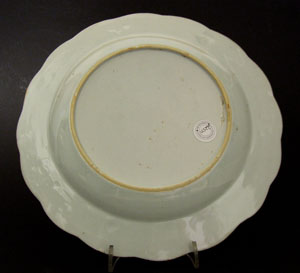
QIANLONG 1736 – 1795. Chinese Export Porcelain
An 18th Century Chinese Export Porcelain Plate with Famille Rose Decoration c.1745-1765. The Greek Mythological Subject Depicted is of The Judgement of Paris with the Figures Shown in a Contrapposto Arrangement. The Border of Gilt Interlocking Scrolls with Shells.
SOLD
- Condition
- Good, a very shallow flake type rim chip to the reverse c.5 x 5mm
- Size
- Diameter : 23 cm (9 inches)
- Provenance
- N/A
- Stock number
- 22551
- References
- For an 18th century Chinese export porcelain plate with this design see see : Chinese Export Porcelain, Chine de Commande (D.F. Lunsingh Scheuleer, Faber and Faber, 1974. ISBN 0-571-08787-6) plate 205. For a The Judgement of Paris teabowl and saucer dated to c.1745 see : The Choice of the Private Trader, The Private Market in Chinese Export Porcelain illustrated from the Hodroff Collection (David S.Howard, Zwemmer,1994. ISBN 0-302-00642-7) page 180, plate 205. For a further example of this Chinese export porcelain design see : Chinese Export Porcelain, Elvehjem Museum of Art (Catherine Coleman Brawer, Elvehjem Museum of Art, University of Wisconsin-Madison,1992. ISBN 932900-30-5) page 139, plate 112.
Information
The Judgement of Paris :
The scene traditionally referred to as The Judgement of Paris illustrates the "Fatal Error" of the son of Priam from the Iliad (attributed to Homer). The original visual source for this version of The Judgement of Paris has traditionally been ascribed to an engraving after Sir Peter Paul Rubens (1577-1640). If one compares the present design to the painting by Rubens of c.1632/3 in the National Gallery in London there many similarities, but the design is possibly closer to Rubens slightly later version of The Judgement of Paris now in the Museo del Prado, this was executed in 1638/9 ( click on the image, see the second painting ). It has also also been suggested the design was based on an engraving by Marcantonio Raimondi of c.1510 -1520 after a designed by Raphael. It has to be noted that there are many differences between the paintings by Rubens or indeed the engraving after Raphael and the Chinese porcelain versions, I think it is therefore important to keep an open mind, especially as the differences can not be explained by the Chinese decorator simply misunderstanding the original source material. The subject matter was popular with painters for many years during the late Renaissance and Baroque periods so attribution is difficult. The classical helmet does not appear in either of the supposed sources for this pattern and clearly it are not something to have been made up by a Chinese decorator. Another possible contender for the origin of this pattern might be the much less well known painting by Hendrick van Balen (1575-1632) of 1599 now in the Gemäldegalerie at Berlin. Another painting that appears fairly close to the Chinese porcelain pattern, which includes the classical helmet, is a painting sold at Christie`s London at South Kensington, Old Masters & 19th Century Works of Art, 10 July 2009, lot 11 ( first painting ). This painting was given the attribution of Studio of Jan Brueghel II (Antwerp 1601-1678) and Hendrik van Balen II (Antwerp 1623-1661). Yet another possibility, possibly the closest of all, is a painting by Frans Wouters (1612 - 59) ( see the last painting ). I feel that the real source will turn out to be much closer to the Chinese porcelain pattern than any painting mentioned above.
Many different versions of this Chinese Porcelain pattern occur, using different colours schemes, arrangements of the scene, as well as numerous border styles, including one with views of Plymouth. The central scene does not vary much, unlike the border designs. It is therefore more than likely there were several different Chinese export porcelain services produced over a number of years reinterpreting this design, the period of production ranged from the mid 1740`s to possibly as late as the 1760`s.




